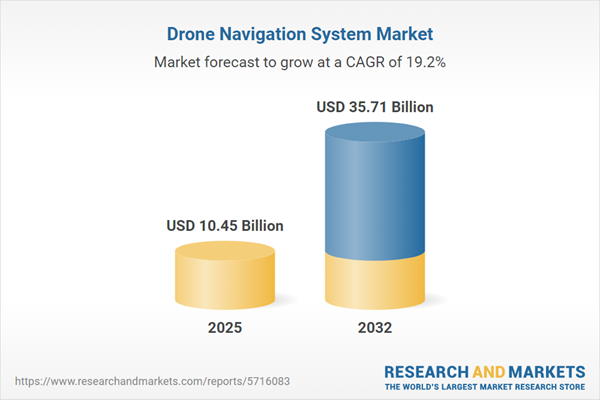Speak directly to the analyst to clarify any post sales queries you may have.
The drone navigation system market is experiencing extensive innovation as organizations seek technology to improve mission autonomy, operational efficiency, and risk management. Senior decision-makers who closely evaluate evolving drone navigation solutions can drive greater organizational resilience and gain a lasting competitive edge.
Market Snapshot: Drone Navigation System Market Size & Growth
The drone navigation system market is on a strong growth trajectory, with market value expected to increase from USD 8.77 billion in 2024 to USD 10.45 billion in 2025 and projected to reach USD 35.71 billion by 2032. This represents a CAGR of 19.17%. Market expansion is driven by broadening commercial applications such as delivery, inspection, and mapping, alongside progressive deployment strategies. Evolving regulatory guidelines, sector-specific operating requirements, and demand for advanced aerial fleet management further support this market's continuous global advancement.
Scope & Segmentation of the Drone Navigation System Market
- Application Areas: Agriculture analytics, logistics, medical transport, inspection, surveying, and advanced mapping all contribute to increased efficiency and adaptability in enterprise and public-sector operations.
- End-Use Sectors: Commercial, military and defense, and recreational segments are integrating UAV technology into vital mission operations, reinforcing sector-wide reliance on drone navigation systems.
- Component Types: The joint use of hardware, software, and associated services forms a foundation for dependable navigation across variable environments and mission complexities.
- UAV Types: Fixed-wing, rotary wing, tilt rotor, VTOL, and hybrid drone solutions are leveraged for differing flight durations, payload requirements, and mission parameters.
- Deployment Modes: Autonomous, semi-autonomous, and manual platforms provide operators with needed flexibility in both routine and highly sophisticated operations.
- Price Ranges: Solutions span premium, mid-range, and entry-level offerings, enabling scalable investment aligned to organizational goals and operational scale.
- Regional Analysis: North America, Latin America, Europe, Middle East, Africa, and Asia-Pacific present distinct technology adoption rates, regulatory approaches, and investment trends, shaping diverse regional opportunities.
- Profiled Companies: Leading industry participants include SZ DJI Technology Co., Ltd., Autel Robotics Co., Ltd., Parrot SA, Yuneec International GmbH, Skydio, Inc., AeroVironment, Inc., 3D Robotics, Inc., Beijing ZeroTech Co., Ltd., PrecisionHawk, Inc., and Draganfly Inc.
This research examines core navigation technologies including inertial measurement units, lidar and radar sensors, sensor fusion techniques, real-time adaptive pathfinding, and integrated cybersecurity capabilities. The report assesses both operator-assisted and fully autonomous swarm operations, capturing the strategic range of deployment across sectors and regions.
Key Takeaways for Senior Decision-Makers
- Modern navigation platforms enhance mission resilience by limiting reliance on single-source signals and therefore maintaining function even in challenging signal environments.
- Strong partnerships across the industry are progressing UAV cybersecurity to create secure, interoperable standards within manufacturing and adoption processes.
- Edge computing, 5G connectivity, and sensor advances collectively improve situational awareness, enabling quicker and better-informed mission responses.
- As sectors such as agriculture, defense, and logistics face unique operational demands, solutions increasingly offer customized analytics, dynamic navigation, and stronger system reliability.
- Organizations pursuing modular upgrades benefit from extended system lifespans, greater compliance, and improved fleet oversight in response to changing regulatory factors.
- Regional leaders focus on distinct objectives: North America accelerates precision agriculture integration, Europe pursues regulatory alignment, and Asia-Pacific develops advanced AI-enabled drone capabilities.
Tariff Impact: Supply Chain Reconfiguration in 2025
Forthcoming US tariffs are prompting manufacturers to reconfigure supply chains for drone navigation systems. This includes diversifying sourcing strategies and increasing domestic output. Partnerships with local technology providers are expanding, ensuring operational continuity and facilitating new innovations. Aftermarket suppliers are emphasizing modular enhancements, helping organizations navigate cost fluctuations and regulatory changes with agility.
Methodology & Data Sources
The report integrates primary interviews with UAV integrators and suppliers, coupled with patent reviews and direct technology demonstrations. Adhering to recognized academic and industry practices, the research equips senior executives with substantiated insights for confident decision-making.
Why This Drone Navigation System Market Report Matters
- Delivers strategic understanding of how drone navigation system development influences risk management and investment choices essential for operational resilience.
- Presents clear sector and geographic insights, supporting efforts in fleet modernization and ensuring alignment with tightening regulatory standards.
- Supports more effective collaboration and innovation among stakeholders, resulting in elevated performance and efficiency in UAV operations.
Conclusion
Evolving drone navigation systems are equipping organizations to handle complex aerial operations with increased adaptability and readiness. This research positions senior leaders to make robust investment choices that strengthen long-term operational resilience.
Additional Product Information:
- Purchase of this report includes 1 year online access with quarterly updates.
- This report can be updated on request. Please contact our Customer Experience team using the Ask a Question widget on our website.
Table of Contents
3. Executive Summary
4. Market Overview
7. Cumulative Impact of Artificial Intelligence 2025
List of Figures
Samples

LOADING...
Companies Mentioned
The key companies profiled in this Drone Navigation System market report include:- SZ DJI Technology Co., Ltd.
- Autel Robotics Co., Ltd.
- Parrot SA
- Yuneec International GmbH
- Skydio, Inc.
- AeroVironment, Inc.
- 3D Robotics, Inc.
- Beijing ZeroTech Co., Ltd.
- PrecisionHawk, Inc.
- Draganfly Inc.
Table Information
| Report Attribute | Details |
|---|---|
| No. of Pages | 191 |
| Published | October 2025 |
| Forecast Period | 2025 - 2032 |
| Estimated Market Value ( USD | $ 10.45 Billion |
| Forecasted Market Value ( USD | $ 35.71 Billion |
| Compound Annual Growth Rate | 19.1% |
| Regions Covered | Global |
| No. of Companies Mentioned | 11 |









